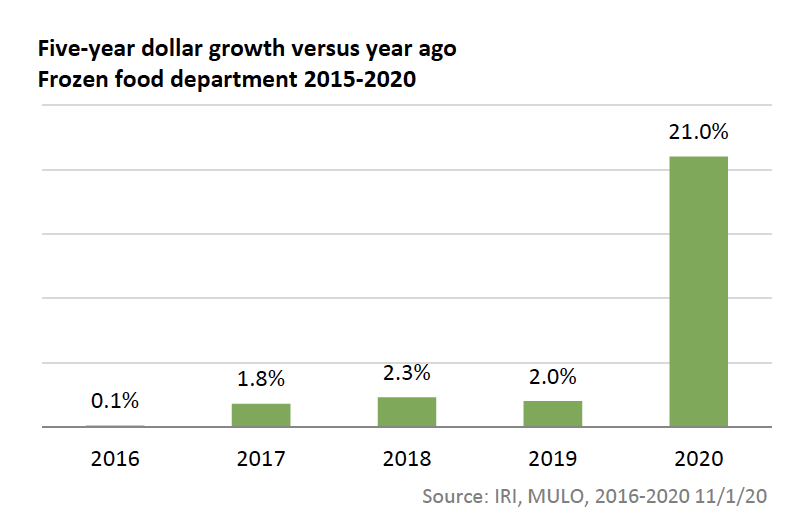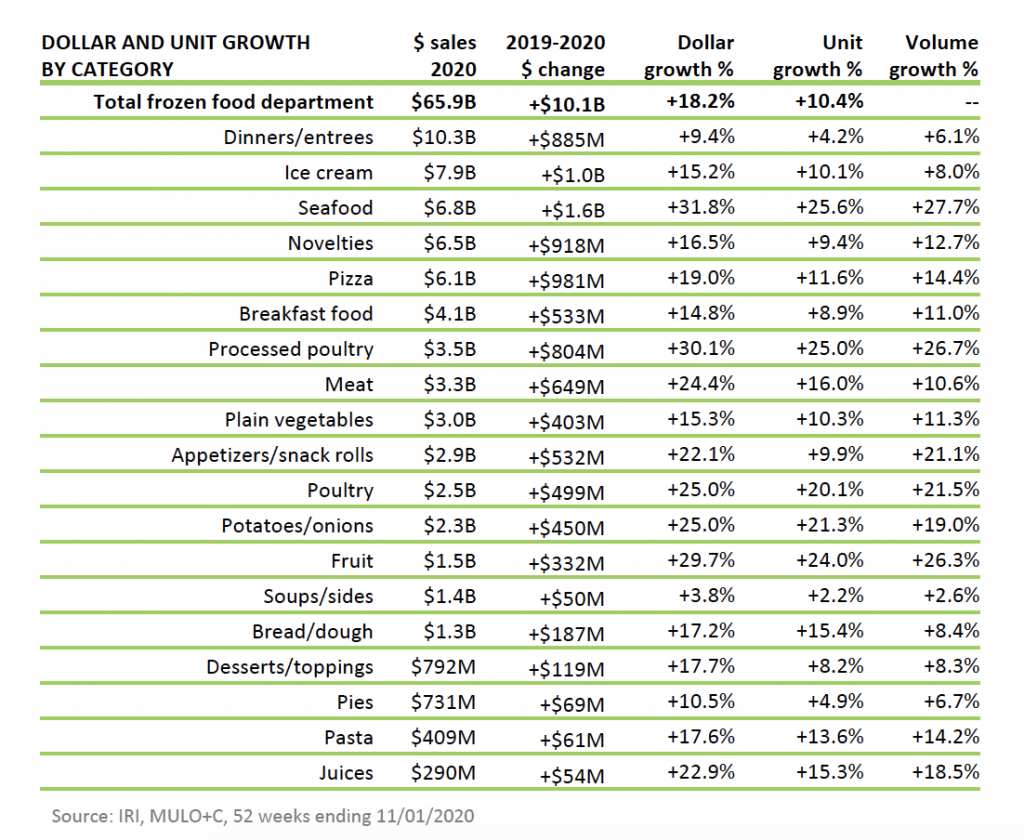Supermarket News cites two new reports from the American Frozen Food Institute (AFFI) and the Food Industry Association (FMI) found that frozen foods were some of the fastest growing categories in the grocery store in 2020.
‘The Power of Frozen 2021 identifies megatrends influencing the demand for frozen foods, including increased engagement in all categories, online shopping and health and well-being,’ says the report.
The frozen food aisle has been a growth driver for retailers since 2016 with acceleration ahead of most other departments. Frozen foods are a pandemic powerhouse ringing in $65.1 billion in retail sales in 2020, a 21% increase compared to a year ago.
Alison Bodor. AFFI president and CEO
Frozen food sales saw a 21% boost in revenue and units by 13.3%, with almost all types of frozen foods seeing a double-digit growth in sales.
Shoppers are nearly a year into the COVID-19 pandemic and are having more family meals at home than ever before. They are looking for meal plans, culinary creativity and convenient, cost-effective solutions. The frozen foods category offers these benefits to shoppers and that’s why we see all areas — from meal ingredients to meal solutions — reaching new audiences and increasing purchases.
Doug Baker. FMI Vice President of Industry Relations

During mid-to-late March when the panic and lockdowns really began to start, sales almost doubled. In the following months sales were up 30% to 40% from 2019. The fourth economic quarter saw a taper off of sales, but were still 15% to 20% higher than in the same quarter in 2019.
According to IRI, Seafood, poultry, and appetizers saw the most gains in the frozen food department (35.3%, 34.7%, 28.9%).
It’s not just about what’s for dinner, especially for our core frozen food consumers. All meal occasions — dinner, lunch, snacks and breakfast — are contributing to an increase in frozen food purchases.
Alison Bodor

According to the report by IRI, Americans’ reliance on frozen food varies widely, from 13% consuming it once a month at most to 14% using frozen foods daily. Many consumers (72%) mix fresh and frozen ingredients in their meal preparation. Amid the pandemic, the share of core frozen food consumers, defined as those who consume frozen food daily or every few days, rose from 35% in 2018 to 39% in 2020. Core frozen food consumers grew among Boomers, singles and women, but the older Millennial remains the largest segment. Core frozen foods consumers purchase across more categories, particularly multi-serve entrees, meat/chicken, meat alternatives and potato items.
In 2020, 42% that bought frozen foods bought them online. This is a 23% increase from 2018. Online frozen food dollar sales increased 75% in 2020, with frozen dinners/entrees, meat, poultry and seafood being the biggest online sellers, added Supermarket News.
Supermarket News noted that frozen food shoppers would be more interested in “real” ingredients, along fresh frozen and products excluding artificial colors.
Power of Frozen 2021 also notes that 72% frozen food consumers want frozen and fresh.
Mixing fresh and frozen in the same meal is a telltale trait of our core frozen food consumers.
Alison Bodor

That report also noted,
- The COVID-19 pandemic prompted changes in purchasing: 57% still purchase more frozen foods, 58% different kinds of frozen foods or 57% are purchasing different brands than they did pre-pandemic.
- Both core and low-frequency frozen food consumers have become more engaged. Buying different items and buying more have a high correlation, underscoring that frozen foods’ vast variety can be one of its most effective recruiting grounds.
- Dinner, snacks and breakfast are top drivers of increased frozen food purchases since the onset of the pandemic. All areas, from meal ingredients to meal solutions have gained in new buyers and increased purchases. Areas of accelerated growth since April are seafood, fruit and multi-serve meal solutions.
- Concerns over shortages or being in-store have greatly diminished since April, but frozen foods’ ease of preparation and more at-home meals are important drivers of buying more frozen foods.
- Greater levels of experimentation along with needing more variety for the more at- home meals and value seeking are driving shoppers to change the kinds of frozen foods they purchase.
- 38% of frozen food shoppers expect they will purchase more in the next few months versus 6% expecting to buy less.
AUTHOR COMMENTARY
The third chart really gives a much broader and detailed analysis of what is being purchased.
While it is certainly true that more consumers gravitated towards more natural options, “natural,” “organic,” “fresh,” “non-gmo,” does not automatically translate to “healthy.” What I mean by that is even though the products may truly be made with clean ingredients, that does not mean that over indulging or just simply eating them in general makes you anymore healthy in terms of weight gain, for example. We note that important fact in our report about the gluttony pandemic in America.
It’s also important to note that many food companies are aware that more and more consumers have become slightly more aware of what they should and should not eat, so these companies have completely overhauled their branding, advertising, and packaging to give the perception that what the consumer is buying is “healthy” and not as bad as the customer may have originally thought. McDonalds is a prime example of that. The clown has been replaced with a more nature-esk feel to make consumers think it is more healthy, when in reality it has gotten worse.
[1] When thou sittest to eat with a ruler, consider diligently what is before thee: [2] And put a knife to thy throat, if thou be a man given to appetite. [3] Be not desirous of his dainties: for they are deceitful meat.Proverbs 23:1-3
The WinePress needs your support! If God has laid it on your heart to want to contribute, please prayerfully consider donating to this ministry. If you cannot gift a monetary donation, then please donate your fervent prayers to keep this ministry going! Thank you and may God bless you.








Frozen meals or TV dinners are 110 percent junk! Take it from me, I speak from experience. TV dinners, frozen foods, and fast food almost every day, and it made me fat and sick. It was terrible. 234 pounds no further than that but it still terrible, it affected me physically as well as physiologically, emotionally, mentally, and socially. Nowadays, I wouldn’t touch a frozen dinner with a 10-foot pole. They’re fake! Hungry Man outta be called “Gluttonous Man,” these insane quantities of so-called food and somehow being marketed as masculine. I guess Romans 1:32 would have a thing to say about that. Stuffing yourself sick is not masculine, it’s piggish, not to mention sinful.
Last time I had McDonald’s was February 2020 as a current gym goer and physically active almost all the time, and once my teeth bit down on it, cravings and hunger that seemed insatiable came over me like a storm front! You eat that garbage and you get hungrier and hungrier, because your body is craving nutrients and protein and it’s saying “I need you to feed me actual food, I’m not getting anything from this junk, so I’ll strike back with more hunger!”
Whether it’s Ronald McDonald or some tree-hugging health nut that’s the mascot, fast food is no good.